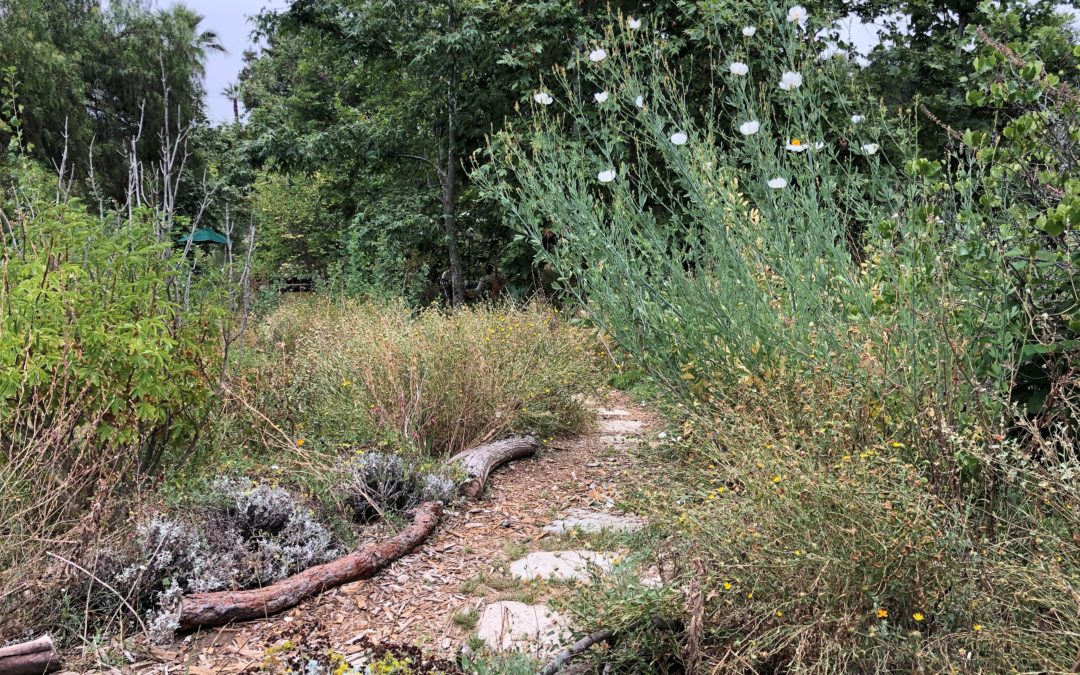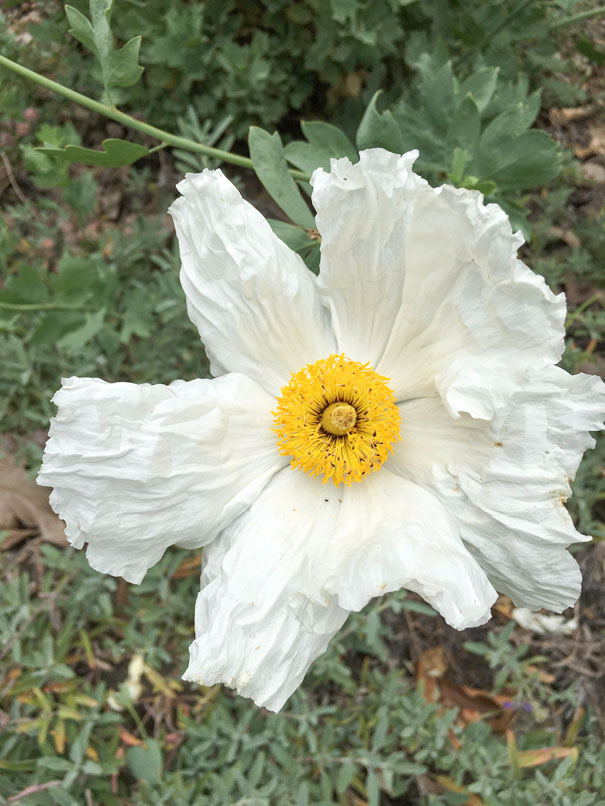Some gardens look the same year-round. Lawns are mowed and treated; hedges are trimmed; weeds are cut-back; and leaves are blown away. In contrast, Arlington Garden wears its changes on its sleeve. The garden appears quite different in August than it does in March.
These changes are rooted in Arlington Garden’s vision of gardening: we are a climate-appropriate, habitat garden using regenerative gardening techniques.
We are a climate-appropriate habitat garden
Arlington Garden is a climate-appropriate, habitat garden, which means we grow plants that evolved in mediterranean climates with wet winters and dry summers. In the summer, these plants go dormant (not dead) and adorn the garden with the subtle colors of dormancy: gold, amber, and sienna predominate, interspersed with white from the native White Sage (Salvia apiana), sage green from Artemisia californica, and punctuated by contrasting rust-toned buckwheat (Eriogonum) seed-heads.
Many so-called “weeds” provide food and shelter to native birds and insects, so we leave some in the garden. If you have visited recently, you may have noticed tall sow thistles (plants in the genus Sonchus), which attract ladybugs and provide ample food for goldfinches. And you will have seen some weedy, non-native grasses, which provide shelter for native bees.
We use regenerative gardening techniques
Regenerative gardening increases soil health by rebuilding biological diversity in the soil. At Arlington Garden, we rebuild the soil by replicating natural processes. We leave fallen leaves and branches on the ground, cover weeds with mulch (rather than pulling them out), and avoid disturbing the soil by digging. Visitors to the garden will see the mounds of mulch in the orange grove, where we use it to limit weed growth and add nitrogen to the soil.
In addition to rebuilding the soil, we completely avoid pesticides, herbicides, and commercial fertilizers. The result is a healthy habitat for plants and local insects and other animals (yes, including humans).
Stewardship challenges during the pandemic
The pandemic has presented the garden with a special set of challenges. Perhaps most obviously to regular visitors, the number of people visiting the garden has climbed dramatically since the stay-at-home orders, and this has led to additional wear-and-tear on the fixtures and increased litter and damage.
We are absolutely committed to welcoming everyone during this difficult time, and the increased litter is a small price to pay for remaining a refuge to our community. But, nonetheless, visitors may notice some damage and disarray from increased traffic.
In addition, our horticultural team has been working reduced hours during the pandemic (they now garden only on Tuesdays while the garden is closed), and our volunteer gardening crew has decreased in size. This means that weeding and maintenance in the garden has had to focus on the biggest tasks, such as clearing trails and repairing infrastructure, and smaller weeding and trimming jobs are currently on hold. These challenges will eventually be addressed, and we hope you see them as comparatively minor issues, given the widespread disruption caused by the global pandemic.
Two visions of gardening
Our vision of gardening explains so much about Arlington Garden that we thought it worthwhile to end this report by laying out two contrasting paradigms of gardening in hopes of illuminating it:
Habitat-centered gardening (Arlington Garden)
- Main aim: to provide a functioning ecosystem for use by humans, plants, and insects and other animal species.
- Instructive example: native plant communities or human-managed wildlife area.
- Gardening technique: rebuild soil and harness natural processes to provide nutrients for plants, conserve and recycle water, and manage “pests” biologically (regenerative gardening).
- Aesthetic ideal: a dense, interconnected ecosystem teeming with life in which plants and animals are appreciated by understanding and interacting with them.
Human-centered gardening (the “standard model”)
- Main aim: human relaxation/recreation or a certain kind of curb-appeal (clean lines)
- Instructive example: a mowed lawn or formal garden with clipped hedges
- Gardening technique: intervening to supercharge and control natural processes (with fertilizers, herbicides, pesticides, generous watering in the summer, and so on)
- Aesthetic ideal: a picturesque landscape appreciated for its visual composition
The parts of each of these two visions reinforce one another. For instance, using techniques to regenerate soil health is how a habitat gardener sustains a dense, interconnected ecosystem teeming with life. Similarly, on the more traditional vision of a garden, a mowed lawn provides a place for recreation and one popular kind of curb appeal.
Part of what is special about Arlington Garden, from the perspective of a gardener, is that although it is a habitat-centered garden, aspects of both visions find expression in it. At Arlington Garden, a picturesque landscape coexists with a dense, interconnected, and healthy ecosystem. And the garden provides habitat for a great diversity of plants and animals while providing space for humans to relax and recreate. In fact, this is what makes Arlington such a great place for humans to recharge and find refuge in it.
But there is not total overlap! The habitat-centered vision of gardening shows that there can be other legitimate aims for gardens than solely human enjoyment and curb appeal. And these aims create space for a radical reimagining of what a healthy, successful garden looks like. In Southern California, in the heat of summer, that kind of successful garden is bathed in yellow, sienna, and terracotta-orange, interspersed with beneficial weeds, frequented by birds and beetles, and decorated with mulch, fallen Sycamore leaves, and an assortment of twigs and branches.
We hope you enjoy the garden with a keen eye for the wildlife that lives there and appreciate this habitat-centered garden in the middle of an urban area.




Recent Comments